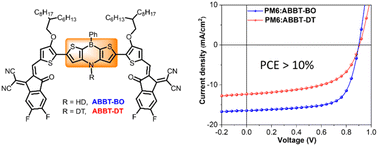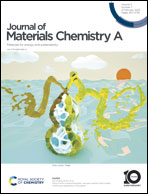1,4-Azaborine based unfused non-fullerene acceptors for organic solar cells†
Abstract
1,4-Azaborine, containing both boron and nitrogen in an aromatic hydrocarbon, displays unique electronic properties compared with its all-carbon analogue and shows great potential as a multiresonant thermally activated delayed fluorescence material. However, conjugated molecules featuring 1,4-azaborine for organic solar cells (OSCs) have not yet been explored. In this study, two novel acceptor–donor–acceptor (A–D–A) conjugated molecules, ABBT-BO and ABBT-DT, using dithieno-1,4-azaborine as the core D unit have been designed and synthesized. Both molecules exhibited excellent solubility, strong and broad absorption and appropriate energy levels, enabling them to be promising candidates for non-fullerene acceptors (NFAs). It was found that the shorter alkyl chain of ABBT-BO could endow the device with superior morphology, resulting in more sufficient exciton dissociation, improved carrier transport and suppressed charge recombination. Impressively, PM6:ABBT-BO based OSCs achieved a power conversion efficiency (PCE) of 10.07% with an open-circuit voltage (VOC) of 0.900 V, a short-circuit current density (JSC) of 16.41 mA cm−2, and a fill factor (FF) of 68.16%, which is the highest efficiency reported for NFAs featuring BN-heteroarenes. This work demonstrates the significant potential of 1,4-BN-heteroarenes for constructing novel NFAs toward high-performance OSCs.

- This article is part of the themed collection: Honorary themed collection for Thomas P. Russell


 Please wait while we load your content...
Please wait while we load your content...